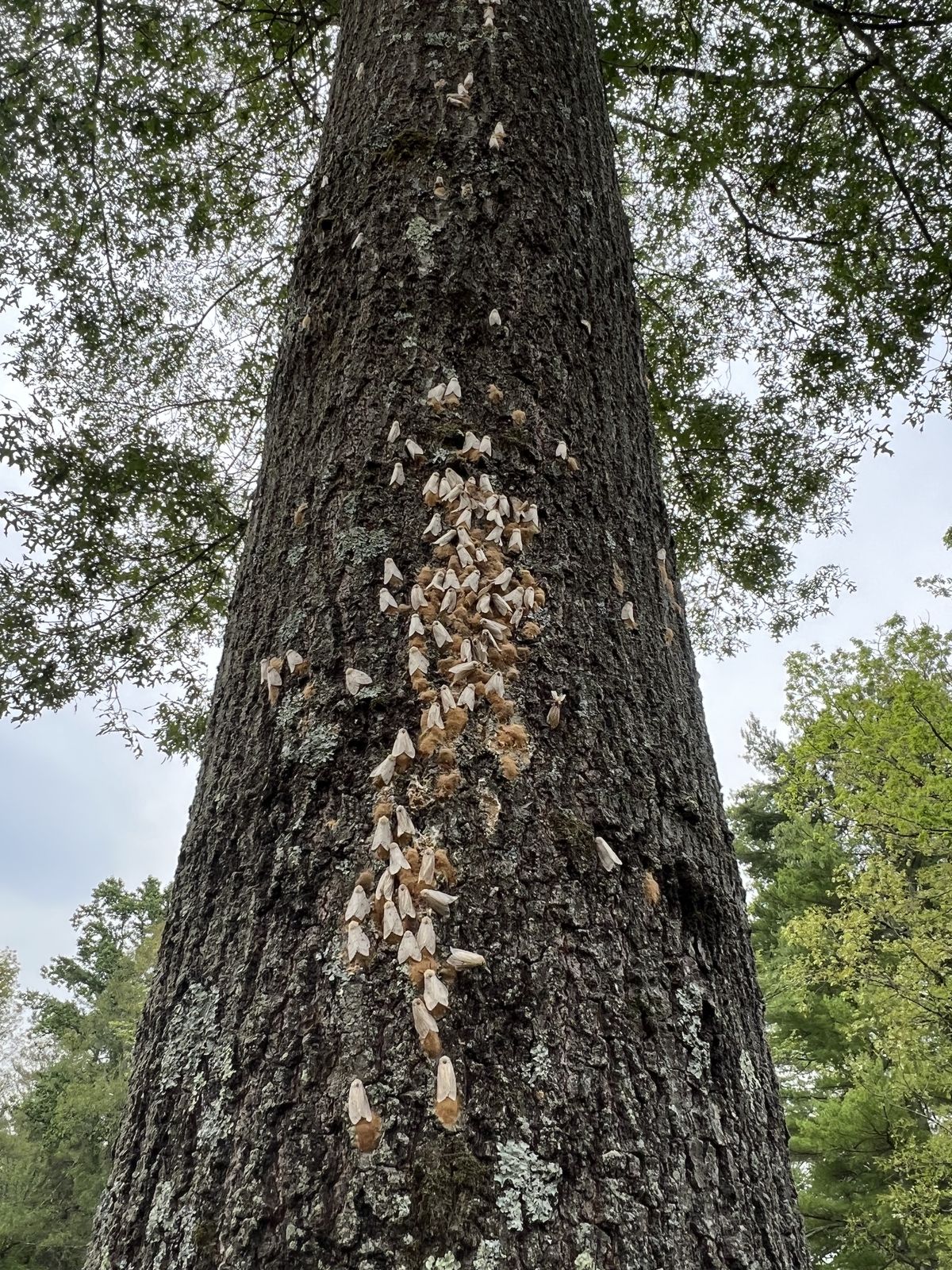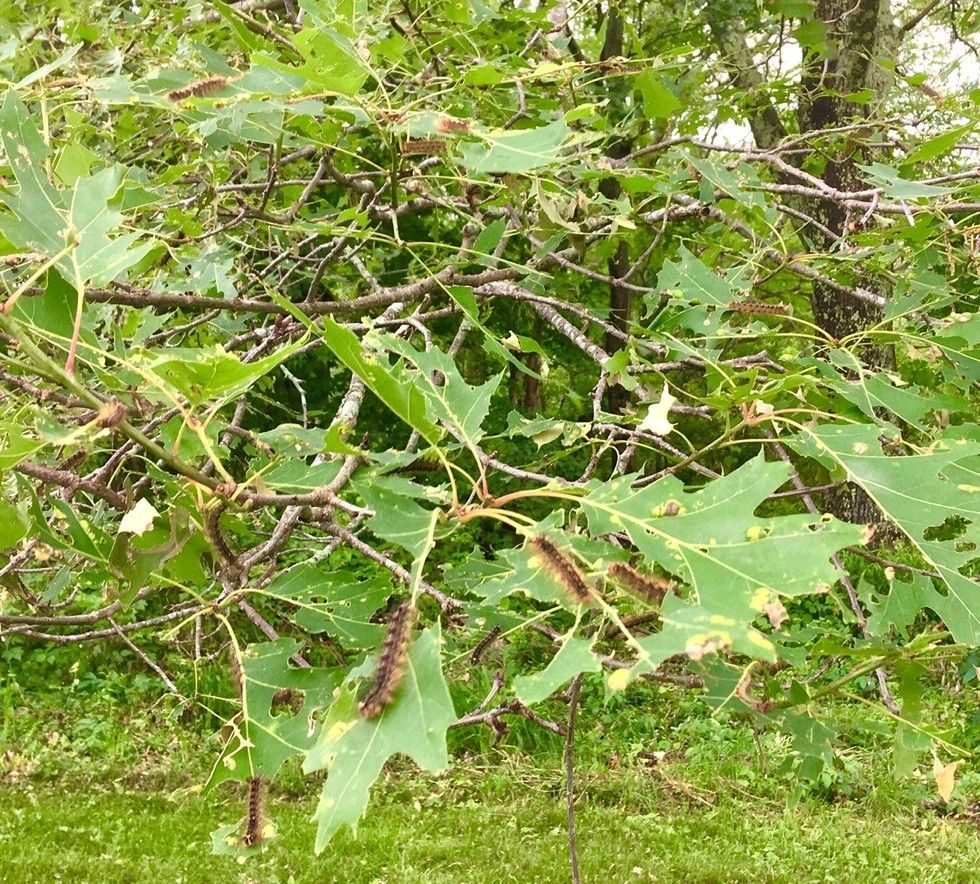Spongy moth and what it is doing to our forests

Female spongy moths lay eggs masses on a black oak tree at the Cary Institute of Ecosystem Studies in Millbrook, N.Y.
Cary Institute of Ecosystem Studies / Lori Quillen

Female spongy moths lay eggs masses on a black oak tree at the Cary Institute of Ecosystem Studies in Millbrook, N.Y.
MILLBROOK, N.Y. — One of the major factors in the cycle of the spongy moth and their proliferation — or lack of proliferation — turns out to be acorns.
Spongy moths, formerly referred to as Gypsy moths for their itinerant ways, were the topic of a lecture Thursday, Jan. 11, by scientists Clive Jones, who has studied the spongy moth for 30 years, and Charles Canham, who has studied northeastern forests for 40 years. Both are emeritus scientists of Cary Institute of Ecosystems Studies, which hosted the lecture.
Spongy moths, natives of Europe and Asia, came to North America in 1868 or 1869, to Medford, Massachusetts. Amateur entomologist Etienne Trouvelot believed he could crossbreed them with silkworms in an attempt to “make a hardy silkworm.”
“He got some egg masses of the spongy moth and set them on the sill of his open window. When they blew into his garden, he could not find them,” said Jones.
By 1891, there was mass defoliation in the Medford area and spongy moths were found in a 200-square-mile area. From there, they began to spread throughout the U.S. and Canada.
Alone, the spongy moth travels by ballooning on silk threads; assisted, humans unwittingly transport eggs laid on cut logs or vehicles.
The life of the spongy moth could be said to begin in July and August, when the flightless female moths emit pheromones to tell males that they’re ready to mate.
They each lay a few hundred eggs, often at the bases of trees. If the moth population is high, they lay eggs anywhere, on garden furniture or on the bumper of a car.
Then, the following May, the eggs hatch. The larvae spend May and June ballooning to new locations on silken threads. They rest under trees during the day, then go up into the tree canopy at night to feed. They prefer oaks but also eat maple, beech, apple, hickory, willow and birch trees, among others.
When the population is very dense and the competition for food is fiercer, they may eat all day and night. Once a tree is defoliated, they’ll move to the next canopy.
In late June and July, the larvae pupate — a caterpiller to moth metamorphosis that lasts a couple of weeks — then they emerge and breed and the cycle begins again.

Acorns and outbreaks
Jones explained that “outbreaks” — or high densities of spongy moths — “occur about every 10 years on average, but like any average, it does not mean there will be outbreaks like clockwork.”
Spongy moths have been defoliating local forests for the last three years running; in June 2022, trail hikers reported that the caterpillars were falling from the canopies “like rain.”
There are two major causes of outbreaks, he continued. One is “high female fecundity,” for example: If one moth laid 500 eggs and 250 were female, 125 of those would live to maturity and lay eggs. So, in year two, there would be 125 females laying eggs, and the third year, over 15,000 would result.
The other cause of outbreaks is the collapse of the white-footed mouse population, he said. White-footed mice eat the pupae as a part of their omnivorous diet.
At this point, we reach the subject of acorns:
“The number of mice is determined by the number of acorns the previous fall,” Jones continued, saying that if there is a moderate to large acorn crop in the fall, more mice survive the winter and begin breeding earlier in the year, in late winter or early spring. When that happens, there is an extra generation of mice, meaning more mice to eat more moth pupae.
Studies at the Cary Institute concluded that “moderate to high mouse densities keep moth populations low,” while it was found “that when the mouse population declines, the spongy moth population increases.”
However, defoliation of oaks can cause the trees to produce fewer acorns, meaning less food for the mice, meaning fewer mice the following spring, meaning more moths, and so on, until the moth population collapses again.
Spongy moth population collapse
There are three major causes of population collapse among the moths.
One is a fungus, Entomophaga maimaiga, which kills the moth at moderate and high densities. It likes cool, wet springs and is more abundant in those conditions.
The more common cause of collapse is Nuclear Polyhedrosis Virus (NPV): When the moths are at high density, they are more stressed by the struggle to find food. Their immunity drops, they are more likely to catch the virus, and many are killed.
The third cause of moth population collapse is lack of food: When they defoliate a large area of trees and run out of food too early, they can’t mature and proceed to egg laying.
Jones said that Cary Institute scientists predict an NPV collapse in 2024: “Whether or not there’ll be a lot or a little defoliation [this year] will really depend on how fast the virus moves through the population. If it moves slowly, there’ll be complete defoliation. If it goes through fast, there’ll be incomplete defoliation.”
The defoliated tree
Canham continued the lecture by saying, “Defoliation by caterpillars is rarely a direct and immediate cause of tree mortality.”
Canham explained that this is due to “carbohydrate economy”: “Basically, photosynthesis during the growing season produces the sugars needed to produce new tissues, and the energy those tissues need for their metabolism.
“But the even more important outcome of a good growing season is the profit leftover after meeting those immediate needs, and that profit is in the form of sugars and starches that act as reserves for use next year.”
Usually, unless the tree is weakened by other factors, it will draw on its reserves to get through this defoliation and produce more leaves that same year.
An exception that Canham has observed at Cary Institute is the understory hemlocks, which don’t make as many reserves and, after a couple years of defoliation in a row, may not recover. Needle trees, DEEP has noted, can be killed if they lose more than 50% of their foliate.
The bottom line
Canham said he worries more about the devastating effects of the emerald ash borer, longhorn beetle, spotted lantern fly and hemlock wooly adelgid than about the spongy moth. He said if a tree is in crisis, a way to help it is to water it to “help replenish its reserves.”
For more information or to view the lecture video, go to www.caryinstitute.org/news-insights/lecture-video/...
Ryan Segalla takes a fadeaway shot over a defender.
FALLS VILLAGE — Housatonic Valley Regional High School’s boys basketball team defeated Pine Plains High School 60-22 in a scrimmage Tuesday, Dec. 9. The non-league preseason game gave both sides an opportunity to run the court ahead of the 2025-26 varsity season.
HVRHS’s senior-heavy roster played with power and poise. The boys pulled ahead early and kept their foot on the gas through to the end.
By halftime the score was 33-8. Junior varsity players subbed in for the second half, but not before the starters got some in-game dunk practice. By the end Housatonic totaled 60 points to Pine Plains’ 22.

Nick Crodelle led the Mountaineers offensively with 13 points. Anthony Labbadia and Wyatt Bayer scored nine points each. Anthony Foley scored eight points. Owen Riemer and Ryan Segalla each scored seven points. Peyton Bushnell hit a three-pointer. Jaxon Visockis and Henry Berry each scored two points.
HVRHS begins Berkshire League competition on the road at Nonnewaug High School Tuesday, Dec. 16, with a 6 p.m. tip off.


Katie Moore delivers toys to the Stuff a Truck campaign held by the Kent Volunteer Fire Department last weekend. Donated toys are collected so that parents, who need some assistance, may provide their children with gifts this Christmas. Accepting the donation are elves Fran Goodsell and Karen Iannucci
KENT — Santa’s elves were toasty warm as they collected toys for the children of Kent.
Keeping with annual tradition, Fran Goodsell and Karen Iannucci manned the Stuff a Truck campaign sponsored by the Kent Volunteer Fire Department on Saturday, Dec. 6, and Sunday, Dec. 7. Sitting in front of a fire pit in the firehouse parking lot between donations from residents, they spoke of the incredible generosity displayed every season. That spirit of giving was clear from the piles of toys heaped on a table.
“This is always so gratifying,” said Goodsell, noting that certain businesses, including High Watch Recovery Center, Wilson’s, and Kent and South Kent schools needed a “shout out” for all they’ve done. She said South Kent School focuses on gifts for older children, which is a group that often is overlooked.
Unwrapped contributions are sought for children 1 to 15 years old who might otherwise find little or nothing from Santa, they said. The bounty will be set up at the Community House on Thursday, allowing parents to come and take what they want. If there are still items left, grandparents are invited to “shop.”
The atmosphere was festive Saturday, as a stuffed dog began barking a Christmas tune whenever someone walked in front of it. A large decked-out bear posted at the parking lot entrance reminded passersby of the event. Visiting children were able to get a close-up look at the fire truck and walk through the firehouse if they wished.
Goodsell and Iannucci were very grateful to those who donated wood for the fire pit. “And so many asked if they could bring us coffee or hot chocolate,” said Iannucci.
Goodsell said many who came talked about having grown children who were recipients of the gifts when their families were struggling. “They are so glad to be able to give back,” she said.
Housatonic Valley Regional High School
FALLS VILLAGE — Principal Ian Strever announces the first quarter marking period Honor Roll at Housatonic Valley Regional High School for the 2025-26 school year.
Highest Honor Roll
Grade 9
Katelyn Holst-Grubbe (North Canaan), Meriel Hughes (Salisbury), Noell Laurry (Kent), Keely Malone (Sharon), April Puerto (Salisbury), Solomon Schmidt (Salisbury), Alastair Schnepf (Wassaic), Olivia Simonds (North Canaan), Marisol Vaughn (Kent), Emery Wisell (Kent).
Grade 10
Mia Belter (Salisbury), Louise Faveau (Salisbury), Addison Green (Kent), Aryanna Horton (Salisbury), Eliana Lang (Salisbury), Lily McCabe (Salisbury), Alison McCarron (Kent), Katherine Money (Kent), Mira Norbet (Sharon), Abigail Perotti (North Canaan), Owen Schnepf (Wassaic), Schuyler Thompson (Falls Village), Federico Vargas Tobon (Salisbury).
Grade 11
John DeDonato (Salisbury), Natasha Dennis (North Canaan), Adelyn Diorio (North Canaan), Sydney Howe (North Canaan), Daniel Lesch (Cornwall), Finian Malone (Sharon), Meadow Moerschell (Kent), Ishaan Tantri (Salisbury).
Grade 12
Lily Beurket (Cornwall), Ryder Conte (Falls Village), Shanaya Duprey (North Canaan), Evelyn Flores-Hernandez (North Canaan), Madelyn Johnson (North Canaan), Alexa Meach (North Canaan), Ibby Sadeh (Falls Village), Alex Woodworth (Salisbury).
High Honor Roll
Grade 9
Anna Ayer (Salisbury), Cody Bodwell (Cornwall), Lainey Diorio (North Canaan), Emma Duffy (Sharon), Carter Finney (North Canaan), Elden Grace (Salisbury), Joanna Haratyk (Torrington), Ava Humes (North Canaan), Tyler LaPlante (North Canaan), Sawyer Margerelli (Salisbury), Lola Miller (Falls Village), Grace O’Brocki (Salisbury), August Olson (Falls Village), Elexis Petkovich (North Canaan), Donald Polk (Cornwall), Justin Sorell (North Canaan), Gia Torzilli (Gaylordsville), Scarlett Visconti (North Canaan), Jaxon Visockis (Salisbury).
Grade 10
Krystin Ackerman (North Canaan), Paige Beeman (North Canaan), Max Bochnovich (Salisbury), Nico Bochnovich (Salisbury), Logan Bronson (Cornwall), Lucius Bryant (Cornwall), Zaira Celso-Cristobal (Sharon), Winter Cheney (Cornwall), Tess Churchill (Salisbury), Niki Clark (Salisbury), Caitlin Devino (North Canaan), Luca Floridis (Salisbury), Samuel Garcia Pulido (North Canaan), Beatrice Gifford (Kent), Angel Gonzalez (Salisbury), Kartel Henry (North Canaan), Paul Losh (Falls Village), Wyatt Merwin (Salisbury), Logan Miller (Falls Village), Sadie Morales Chapell (Salisbury), Nova Pratt (North Canaan), Karmela Quinion (North Canaan), Vilija Salazar (Kent), Juliette Trabucco (Kent), Payton Wagner (North Canaan), Olivia Whitney (North Canaan).
Grade 11
Adelaide Almeida (Salisbury), Hayden Bachman (Falls Village), Byron Bell (Cornwall), Sophia Camphouse (Sharon), Olivia Claydon (North Canaan), Georgie Clayton (Salisbury), Sophia DeDominicis Fitzpatrick (Sharon), Christian DeDonato (Salisbury), Layla DiDomenico (Kent), Carmela Egan (Salisbury), Kellie Eisermann (Salisbury), Levi Elliott (Millerton), Lydia Fleming (North Canaan), Guadalupe Flores-Hernandez (North Canaan), Grace Graney (Falls Village), Alexa Hoadley (Kent), Jonas Johnson (North Canaan), Aiden Krupa (Torrington), Makenzie Lidstone (Salisbury), Francisco Mendoza Ratzan (North Canaan), Daniel Moran (Norfolk), Jackson Olson (Falls Village), Logan Padelli (North Canaan), Gustavo Portillo (North Canaan), Darwin Wolfe (Falls Village), Nathan Zani (Ashley Falls), Ivy Zheng (North Canaan).
Grade 12
Hayden Bell (Cornwall), Genesis Bravo Guilcashina (North Canaan), Olivia Brooks (Salisbury), Victoria Brooks (Salisbury), Mia DiRocco (Cornwall), Anthony Foley (North Canaan), Anna Gillette (Salisbury), Julissa Gonzalez (Cornwall), Kierra Greene (North Canaan), Adam Hock (Kent), Sara Ireland (Salisbury), Hannah Johnson (North Canaan), Riley Mahaffey (Amenia), Simon Markow (Cornwall), Madeline Mechare (Falls Village), Madison Melino (Austerlitz), Daphne Paine (North Canaan), Celeste Trabucco (Kent), Silas Tripp (Falls Village), Ayden Wheeler (Amenia).
Honor Roll
Grade 9
Jonathan Bindley (Cornwall), Cullen Bonis (Kent), Phoebe Conklin (Salisbury), Connor Crane (North Canaan), Isabella Curtis (Norfolk), Jessica Davis (North Canaan), Ciri Dean (North Canaan), Lyla Diorio (North Canaan), Patrick Hafner (Falls Village), Ryan Hinman (North Canaan), Harrison Morey (North Canaan), Jenaveeve Wagner (North Canaan).
Grade 10
Lyla Banffy (Kent), Jackson Brammer (Sharon), Peyton Bushnell (Falls Village), Alisa Christiansen Madsen (North Canaan), Lilliana Hurley (North Canaan), Chase Kading (Millerton), Ayden Lemmy (Falls Village), McKenzie Lotz (Ashley Falls), Christopher Piscitello (North Canaan), Camila Sanchez Guerrero (Cornwall), Henry Skuza (Millbrook), Giovani Solorzano-Lemus (North Canaan), Nathan Young (Cornwall).
Grade 11
Bennett Wyatt Bayer (Salisbury), Sofia Bindley (Cornwall), Selena Black (Cornwall), Karen Chavez-Sanchez (Salisbury), Riley Heady (Sharon), Carson Riva (North Canaan), Ryan Segalla (Salisbury), Alanna Tatro (North Canaan), Juan Xeche Coche (North Canaan).
Grade 12
Peter Austin (Kent), Katherine Crane (North Canaan), Richard Crane (North Canaan), Nicholas Crodelle (Sharon), Mollie Ford (Falls Village), Nicolas Gonzalez (Salisbury), Maureen Graney (Falls Village), Taylor Green (Kent), Marc Hafner (Falls Village), Chloe Hill (Salisbury), Abram Kirshner (Kent), Logan Labshere (North Canaan), Eric Lopez Espinosa (Salisbury), Owen Riemer (North Canaan), Ava Segalla (Salisbury), Cole Simonds (North Canaan).
NORTH CANAAN — The Board of Finance elected its officers at the first meeting of the new term on Wednesday, Dec. 10.
Doug Humes was re-elected as chair, and Brian Johnson was elected vice chair.
The board also filled a two-year vacancy by unanimously appointing Christian Allyn, who was sworn in immediately by Town Clerk Jean Jacquier.
Members then reviewed several budget line items that have exceeded their appropriations and will require the approval at a town meeting.
First Selectman Jesse Bunce, who attended the meeting, said the Board of Selectmen will likely call for that town meeting when it convenes on Monday, Dec. 15.